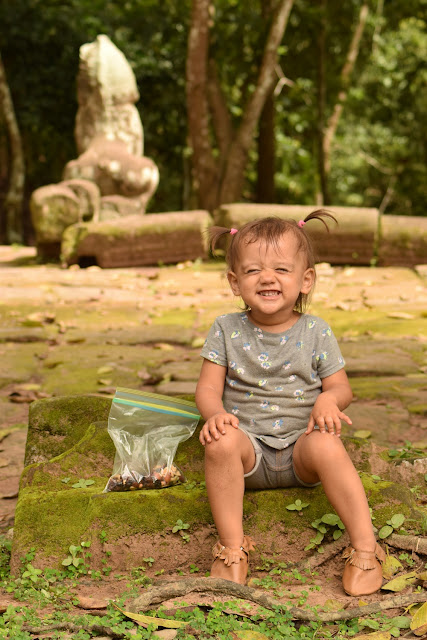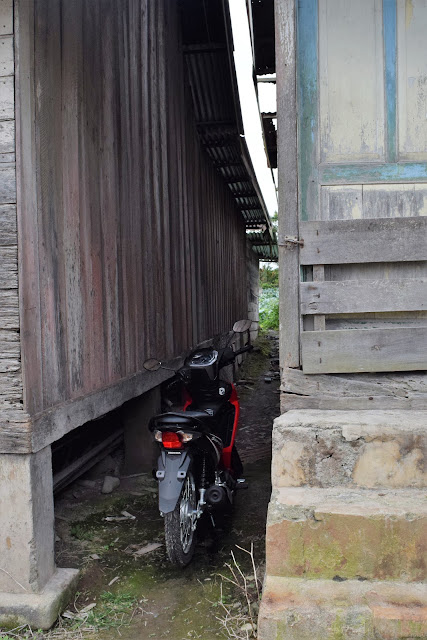My Malaysian Journey Of Learning.
Meilin
11:11 PM
We took these pictures on our 513 step hike to a local Hindu temple. I love the quotes on the stairs; I feel they are a representation of our stay in Malaysia. I am going to go through each one and the significance it provided in my journey.
Every meaningful journey begins with the first step.
Often, the step first taken is the most important. It is the part where you step out of your original limits, and stretch yourself. At least it was for us in this case. I remember my first month there being stressful, lonely, and discouraging. The culture change gave us quite a shock. Some days, I wanted nothing more than to give up. I'm so grateful I didn't. The trials we face at the beginning are incredibly important to the rest of our journey. It just takes some time to adjust. The first step is the hardest to take, but the most important start to your journey of learning.
Faith is our greatest companion on every journey.
Faith is vital. I really have to give the credit to my parents. I was pretty insecure about the idea of moving abroad. When we got there I depended on their enthusiasm until I could develop my own. Often, our life's journey brings us around a bend. We don't know what to expect. It's in these times that we have to really keep our faith and trust that our circumstances can and will change. Mine certainly did. But honestly, it was less of my circumstances changing, and more of my perception changing. As I learned to love and appreciate differences I was able to shift my day-to-day perception of the cultures around me and to change myself for the better. Faith was the key to change. As I believed and hoped that I would learn to love Penang, the hope turned into reality. As long as we hold onto faith, we can get through the hardest of times.
Love is the spirit that motivates us every step of the way.
Love is the power pushing us towards our destination. While we were still adjusting, I grew to love Penang and that love became my motivation to keep going. Through it I wanted to learn more, and I wasn't so uncomfortable or scared of our cultural differences. I adapted myself to be more like them. The food we ate inspired me to cook more and now I love cooking Asian food. I loved the sense of community that was expressed as well as the general kindness and generosity. Love continues to be my motivation as I use the success of that journey to encourage my current one.
Look back at how far you've gone, and know it was worth every step.
As I reflect on where I started and where I am now, there is no doubt that the journey was vital to my personal growth. My experiences stretched me and challenged me in ways I never thought I would have to experience, but I know that it was worth it. In truth, we can't learn certain concepts until we are pushed out of our current limits, wherever that may be. The whole process of adjusting to the cultures was incredibly difficult, but now I am comfortable when I see them. I learned from the different people and now I love learning about our differences, especially our religious differences. The whole reason we are on earth is to learn and understand things that we can't and wouldn't be able to otherwise. I don't know where I would be now if I hadn't gone. I just know that I am better for going, Sometimes we have to go through the lowest lows to reach the highest highs. My experience is living proof of that. When I look back at our year there my heart is full. I see the pain I felt, and the unmistakable joy. And I know that it couldn't be more worth it.
Sometimes it's not where you went, or how you got there, but that you chose to go.
Sometimes the how doesn't matter so much. Sometimes it's just the fact that you chose to do or go wherever you did. When I look back at our journey to Malaysia, I don't think about the plane ride (although I have to admit, it was pretty sweet) but I think about the emotions I was feeling. I think about my anticipation and nervousness, as well as the excitement. Sometimes in the moment it doesn't matter where we were flying to. What matters is the faith it took to go, the emotions I felt, the things I learned, and focus on my thoughts. That we were willing to experience and immerse ourselves in our culinary and religious diversity. I am more grateful than anything that we did. We chose to go and we all are better for it.
Greatness doesn't lie in strength, but in our knowledge to use it.
I think this quote is so profound. it's so true! Our knowledge is what's going to stay with us forever, and that's why it's so important to gain. our current of past knowledge is nothing compared to what it will be in the future. As we continue to learn we transform ourselves and the world around us. that is what makes us great. Greatness is serving, helping, and teaching, the change we bring through service can be magical. We can all be magicians off the world by understanding and fulfilling our purpose in life. I am one of many trying to use my knowledge to make the world a better place. I have learned so much this past year and I hope I will continue to use it to change my surroundings. I am so grateful that I had such a remarkable experience. It fills me with excitement to know that this journey was only the beginning.
Every meaningful journey begins with the first step.
Often, the step first taken is the most important. It is the part where you step out of your original limits, and stretch yourself. At least it was for us in this case. I remember my first month there being stressful, lonely, and discouraging. The culture change gave us quite a shock. Some days, I wanted nothing more than to give up. I'm so grateful I didn't. The trials we face at the beginning are incredibly important to the rest of our journey. It just takes some time to adjust. The first step is the hardest to take, but the most important start to your journey of learning.
Faith is our greatest companion on every journey.
Faith is vital. I really have to give the credit to my parents. I was pretty insecure about the idea of moving abroad. When we got there I depended on their enthusiasm until I could develop my own. Often, our life's journey brings us around a bend. We don't know what to expect. It's in these times that we have to really keep our faith and trust that our circumstances can and will change. Mine certainly did. But honestly, it was less of my circumstances changing, and more of my perception changing. As I learned to love and appreciate differences I was able to shift my day-to-day perception of the cultures around me and to change myself for the better. Faith was the key to change. As I believed and hoped that I would learn to love Penang, the hope turned into reality. As long as we hold onto faith, we can get through the hardest of times.
Love is the spirit that motivates us every step of the way.
Love is the power pushing us towards our destination. While we were still adjusting, I grew to love Penang and that love became my motivation to keep going. Through it I wanted to learn more, and I wasn't so uncomfortable or scared of our cultural differences. I adapted myself to be more like them. The food we ate inspired me to cook more and now I love cooking Asian food. I loved the sense of community that was expressed as well as the general kindness and generosity. Love continues to be my motivation as I use the success of that journey to encourage my current one.
Look back at how far you've gone, and know it was worth every step.
As I reflect on where I started and where I am now, there is no doubt that the journey was vital to my personal growth. My experiences stretched me and challenged me in ways I never thought I would have to experience, but I know that it was worth it. In truth, we can't learn certain concepts until we are pushed out of our current limits, wherever that may be. The whole process of adjusting to the cultures was incredibly difficult, but now I am comfortable when I see them. I learned from the different people and now I love learning about our differences, especially our religious differences. The whole reason we are on earth is to learn and understand things that we can't and wouldn't be able to otherwise. I don't know where I would be now if I hadn't gone. I just know that I am better for going, Sometimes we have to go through the lowest lows to reach the highest highs. My experience is living proof of that. When I look back at our year there my heart is full. I see the pain I felt, and the unmistakable joy. And I know that it couldn't be more worth it.
Sometimes it's not where you went, or how you got there, but that you chose to go.
Sometimes the how doesn't matter so much. Sometimes it's just the fact that you chose to do or go wherever you did. When I look back at our journey to Malaysia, I don't think about the plane ride (although I have to admit, it was pretty sweet) but I think about the emotions I was feeling. I think about my anticipation and nervousness, as well as the excitement. Sometimes in the moment it doesn't matter where we were flying to. What matters is the faith it took to go, the emotions I felt, the things I learned, and focus on my thoughts. That we were willing to experience and immerse ourselves in our culinary and religious diversity. I am more grateful than anything that we did. We chose to go and we all are better for it.
Greatness doesn't lie in strength, but in our knowledge to use it.
I think this quote is so profound. it's so true! Our knowledge is what's going to stay with us forever, and that's why it's so important to gain. our current of past knowledge is nothing compared to what it will be in the future. As we continue to learn we transform ourselves and the world around us. that is what makes us great. Greatness is serving, helping, and teaching, the change we bring through service can be magical. We can all be magicians off the world by understanding and fulfilling our purpose in life. I am one of many trying to use my knowledge to make the world a better place. I have learned so much this past year and I hope I will continue to use it to change my surroundings. I am so grateful that I had such a remarkable experience. It fills me with excitement to know that this journey was only the beginning.






































